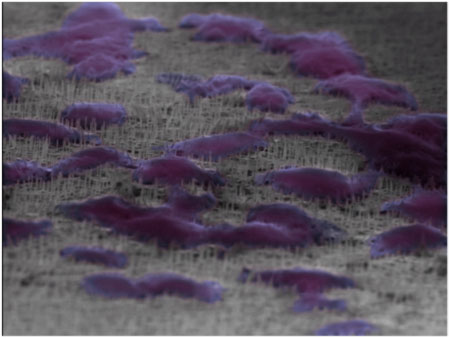| Posted: Mar 14, 2011 | |
Perspectives for live cellular biosensing with nanowire arrays |
|
| (Nanowerk Spotlight) Most applications of nanostructured materials rely on their high-aspect ratio providing them particular physical features. Another considerable advantage comes from the size compatibility of the nanomaterials with biological samples, opening new perspectives in bionics and biosensing. | |
| In order to get a true picture of the processes and events that take place inside unmodified, living cells, probing techniques need to be non-destructive, noninvasive and in real-time. Due to their small dimensions, high-aspect ratio nanomaterials such as nanofibers, nanowires and carbon nanotubes are ideal for cellular applications since they can cross the cell membrane without causing significant damage (see for instance: "Nanotechnology endoscope for living cells"). | |
| "A particularly promising tool consists of arrays of vertically aligned nanostructures on a support," Karen Martinez, associate professor at the University of Copenhagen's Nano-Science Center, tells Nanowerk. "In particular, semiconductor nanowires attract a lot of interest because of their uniformity, reproducibility and possibility of fine-tuning their intrinsic properties – physical dimensions, crystal structure, electrical and optical properties, etc.". | |
| In a new work, Martinez and her group have shown, for the first time, the spontaneous and close interface of arrays of vertically aligned indium arsenide nanowires with two relevant cell lines, human embryonic kidney cells and rat embryonic dorsal root ganglion neurons. The simple and gentle method of interfacing the cells with nanowires by using an array of vertically aligned nanowires as a cell-culture surface leads to a close cell-nanowire interface without using external forces or functionalizing the nanowires. The method keeps both cell types alive and functional for several days. | |
| Martinez points out that the longevity of cells on nanowire arrays made it possible to study long-term cellular processes, such as DNA uptake and subsequent protein expression. | |
 |
|
| This picture was taken with a scanning electron microscope and artificially colored. It shows several cells from human embryonic kidney (HEK293) interfaced on arrays of indium arsenide nanowires arrays. (Image: Karen Martinez, University of Copenhagen) | |
| The researchers published their findings in a recent issue of Small ("Intact Mammalian Cell Function on Semiconductor Nanowire Arrays: New Perspectives for Cell-Based Biosensing"). | |
| The team's study was performed on indium arsenide nanowire arrays fabricated by molecular beam epitaxy. The nanowires were vertically aligned and had a hexagonal cross section, each one being capped by the gold particle that catalyzed the growth. The typical dimensions were 1-3 µm in length, 100–300 nm in diameter, and the average density of the nanowire arrays was 31±1 nanowires per 100 µm2. | |
| The team investigated a series of critical cell functions and demonstrated – by a combination of scanning electron micrography and confocal fluorescence microscopy – that the cells were not impaired by their close interface with the arrays of vertically aligned nanowires. | |
| The results demonstrate the low invasiveness of indium arsenide nanowire arrays, which, combined with the unique physical properties of indium arsenide, open up their potential for cellular investigations. | |
| "Moreover" says Martinez, "we demonstrate that indium arsenide nanowire arrays are compatible with standard cell protocols crucial for future investigations in living cells, such as culturing, transfection, heterologous expression, and live-cell fluorescence imaging". | |
| According to the researchers, future applications of these arrays cover very broad applications going from delivery of biomaterials into cells to detection of cellular events inside living cells. They will thus open up various medical applications towards personalized nanomedicine (diagnostics) and drug discovery. | |
 By
Michael
Berger
– Michael is author of three books by the Royal Society of Chemistry:
Nano-Society: Pushing the Boundaries of Technology,
Nanotechnology: The Future is Tiny, and
Nanoengineering: The Skills and Tools Making Technology Invisible
Copyright ©
Nanowerk LLC
By
Michael
Berger
– Michael is author of three books by the Royal Society of Chemistry:
Nano-Society: Pushing the Boundaries of Technology,
Nanotechnology: The Future is Tiny, and
Nanoengineering: The Skills and Tools Making Technology Invisible
Copyright ©
Nanowerk LLC
|
|
|
Become a Spotlight guest author! Join our large and growing group of guest contributors. Have you just published a scientific paper or have other exciting developments to share with the nanotechnology community? Here is how to publish on nanowerk.com. |
|
